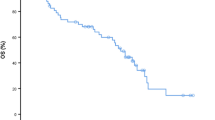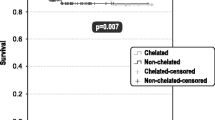Summary
Background
Primary and secondary myelofibrosis (PMF and SMF) are malignant diseases of hematopoietic stem cell characterized by the neoplastic myeloproliferation and a strong inflammatory milieu. The prognostic nutritional index (PNI) integrates information on albumin and absolute lymphocyte count (ALC) and reflects the inflammatory, nutritional and immune status of a patient. The clinical and prognostic significance of albumin, ALC and PNI in patients with myelofibrosis has not been previously investigated.
Methods
We retrospectively analyzed a cohort of 83 myelofibrosis patients treated in our institution from 2006 to 2017. Albumin, ALC and PNI were assessed in addition to other disease specific markers.
Results
The PMF and SMF patients had significantly lower ALC and PNI but similar albumin compared to controls. Lower albumin was significantly associated with older age and parameters reflecting more aggressive disease biology (e.g. anemia, lower platelet levels, higher lactate dehydrogenase (LDH), circulatory blasts, transfusion dependency, blast phase disease), inflammation (higher C reactive protein (CRP), constitutional symptoms) and higher degree of bone marrow fibrosis. Lower ALC was significantly associated with lower white blood cells (WBC) and lower circulatory blasts. Low PNI was associated with lower albumin, lower ALC, anemia, lower WBCs, lower serum iron and lower transferrin saturation. There was no difference in albumin, ALC and PNI regarding the driver mutations. In multivariate analysis adjusted for age and gender, low albumin (hazard ratio [HR] = 4.61, P = 0.001), low ALC (HR = 3.54, P = 0.004) and Dynamic International Prognostic Scoring System (DIPSS) (HR = 2.45, P = 0.001) were able to predict inferior survival independently of each other. Accordingly, low PNI (HR = 4.32, P < 0.001) predicted poor survival independently of DIPSS (HR = 3.31, P < 0.001).
Conclusion
Assessing albumin, ALC and PNI might improve prognostication in patients with myelofibrosis and could assist in recognition of patients under increased risk of death.



Similar content being viewed by others
References
Arber DA, Orazi A, Hasserjian R, et al. The 2016 revision to the World Health Organization classification of myeloid neoplasms and acute leukemia. Blood. 2016;127(20):2391–405.
Sliwa T, Beham-Schmid C, Burgstaller S, et al. Austrian recommendations for the management of primary myelofibrosis, post-polycythemia vera myelofibrosis and post-essential thrombocythemia myelofibrosis: an expert statement. Wien Klin Wochenschr. 2017;129(9–10):293–302.
Hasselbalch HC. Perspectives on chronic inflammation in essential thrombocythemia, polycythemia vera, and myelofibrosis: is chronic inflammation a trigger and driver of clonal evolution and development of accelerated atherosclerosis and second cancer? Blood. 2012;119(14):3219–25.
Hultcrantz M, Kristinsson SY, Andersson TM, et al. Patterns of survival among patients with myeloproliferative neoplasms diagnosed in Sweden from 1973 to 2008: a population-based study. J Clin Oncol. 2012;30(24):2995–3001.
Yogarajah M, Tefferi A. Leukemic transformation in myeloproliferative neoplasms: a literature review on risk, characteristics, and outcome. Mayo Clin Proc. 2017;92(7):1118–28.
Barosi G, Mesa RA, Thiele J, et al. Proposed criteria for the diagnosis of post-polycythemia vera and post-essential thrombocythemia myelofibrosis: a consensus statement from the International Working Group for Myelofibrosis Research and Treatment. Leukemia. 2008;22(2):437–8.
Cervantes F, Dupriez B, Pereira A, et al. New prognostic scoring system for primary myelofibrosis based on a study of the International Working Group for Myelofibrosis Research and Treatment. Blood. 2009;113(13):2895–901.
Passamonti F, Cervantes F, Vannucchi AM, et al. A dynamic prognostic model to predict survival in primary myelofibrosis: a study by the IWG-MRT (International Working Group for Myeloproliferative Neoplasms Research and Treatment). Blood. 2010;115(9):1703–8.
Tayek JA. Albumin synthesis and nutritional assessment. Nutr Clin Pract. 1988;3(6):219–21.
Fock RA, Blatt SL, Beutler B, et al. Study of lymphocyte subpopulations in bone marrow in a model of protein-energy malnutrition. Nutrition. 2010;26(10):1021–8.
Rocha NP, Fortes RC. Total lymphocyte count and serum albumin as predictors of nutritional risk in surgical patients. Arq Bras Cir Dig. 2015;28(3):193–6.
Saito H, Nomura K, Hotta M, Takano K. Malnutrition induces dissociated changes in lymphocyte count and subset proportion in patients with anorexia nervosa. Int J Eat Disord. 2007;40(6):575–9.
Bharadwaj S, Ginoya S, Tandon P, et al. Malnutrition: laboratory markers vs nutritional assessment. Gastroenterol Rep. 2016;4(4):272–80.
Zhang Z, Pereira SL, Luo M, Matheson EM. Evaluation of blood Biomarkers associated with risk of malnutrition in older adults: a systematic review and meta-analysis. Nutrients. 2017;9(8):E829.
Blackburn GL, Bistrian BR, Maini BS, Schlamm HT, Smith MF. Nutritional and metabolic assessment of the hospitalized patient. JPEN J Parenter Enteral Nutr. 1977;1(1):11–22.
Onodera T, Goseki N, Kosaki G. Prognostic nutritional index in gastrointestinal surgery of malnourished cancer patients. Nihon Geka Gakkai Zasshi. 1984;85(9):1001–5.
Perisa V, Zibar L, Knezovic A, Perisa I, Sincic-Petricevic J, Aurer I. Prognostic nutritional index as a predictor of prognosis in patients with diffuse large B cell lymphoma. Wien Klin Wochenschr. 2017;129(11–12):411–9.
Sun K, Chen S, Xu J, Li G, He Y. The prognostic significance of the prognostic nutritional index in cancer: a systematic review and meta-analysis. J Cancer Res Clin Oncol. 2014;140(9):1537–49.
Okada S, Shimada J, Kato D, Tsunezuka H, Teramukai S, Inoue M. Clinical significance of prognostic nutritional index after surgical treatment in lung cancer. Ann Thorac Surg. 2017;104(1):296–302.
Yang Y, Gao P, Chen X, et al. Prognostic significance of preoperative prognostic nutritional index in colorectal cancer: results from a retrospective cohort study and a meta-analysis. Oncotarget. 2016;7(36):58543–52.
Lee JY, Kim HI, Kim YN, et al. Clinical significance of the prognostic nutritional index for predicting short- and long-term surgical outcomes after gastrectomy: a retrospective analysis of 7781 gastric cancer patients. Medicine (Baltimore). 2016;95(18):e3539.
Lee SH, Chung MJ, Kim B, et al. The significance of the prognostic nutritional index for all stages of pancreatic cancer. Nutr Cancer. 2017;69(3):512–9.
Scherber RM, Mesa RA. Relevance of weight loss, splenomegaly, and hypocholesterolemia in the treatment of myeloproliferative neoplasms—implications for a JAK2 inhibitor era. Oncol Hematol Rev. 2011;7(1):61–3.
Cervantes F, Hernandez-Boluda JC, Villamor N, Serra A, Montserrat E. Assessment of peripheral blood lymphocyte subsets in idiopathic myelofibrosis. Eur J Haematol. 2000;65(2):104–8.
Thiele J, Kvasnicka HM, Facchetti F, Franco V, van der Walt J, Orazi A. European consensus on grading bone marrow fibrosis and assessment of cellularity. Haematologica. 2005;90(8):1128–32.
Baxter EJ, Scott LM, Campbell PJ, et al. Acquired mutation of the tyrosine kinase JAK2 in human myeloproliferative disorders. Lancet. 2005;365(9464):1054–61.
Bilbao-Sieyro C, Santana G, Moreno M, et al. High resolution melting analysis: a rapid and accurate method to detect CALR mutations. PLoS ONE. 2014;9(7):e103511.
Pardanani A, Guglielmelli P, Lasho TL, et al. Primary myelofibrosis with or without mutant MPL: comparison of survival and clinical features involving 603 patients. Leukemia. 2011;25(12):1834–9.
Lucijanic M, Petrovecki M. Analysis of censored data. Biochem Med. 2012;22(2):151–5.
Lucijanic M, Skelin M, Lucijanic T. Survival analysis, more than meets the eye. Biochem Med. 2017;27(1):14–8.
Lucijanic M. Survival analysis in clinical practice: analyze your own data using an Excel workbook. Croat Med J. 2016;57(1):77–9.
Nunez J, Minana G, Bodi V, et al. Low lymphocyte count and cardiovascular diseases. Curr Med Chem. 2011;18(21):3226–33.
Mesa RA, Verstovsek S, Gupta V, et al. Effects of ruxolitinib treatment on metabolic and nutritional parameters in patients with myelofibrosis from COMFORT-I. Clin Lymphoma Myeloma Leuk. 2015;15(4):214–221.e1.
Gluck T, Kiefmann B, Grohmann M, Falk W, Straub RH, Scholmerich J. Immune status and risk for infection in patients receiving chronic immunosuppressive therapy. J Rheumatol. 2005;32(8):1473–80.
Polverelli N, Breccia M, Benevolo G, et al. Risk factors for infections in myelofibrosis: role of disease status and treatment. A multicenter study of 507 patients. Am J Hematol. 2017;92(1):37–41.
Author information
Authors and Affiliations
Corresponding author
Ethics declarations
Conflict of interest
M. Lucijanic, I. Veletic, D. Rahelic, V. Pejsa, D. Cicic, M. Skelin, A. Livun, K.M. Tupek, T. Stoos-Veic, T. Lucijanic, A. Maglicic, and R. Kusec declare that they have no competing interests.
Ethical standards
All procedures performed in studies involving human participants were in accordance with the ethical standards of the Institutional Review Board and/or national research committee and with the 1964 Helsinki declaration and its later amendments or comparable ethical standards. Informed consent was obtained from all subjects in whom molecular studies were performed.
Rights and permissions
About this article
Cite this article
Lucijanic, M., Veletic, I., Rahelic, D. et al. Assessing serum albumin concentration, lymphocyte count and prognostic nutritional index might improve prognostication in patients with myelofibrosis. Wien Klin Wochenschr 130, 126–133 (2018). https://doi.org/10.1007/s00508-018-1318-z
Received:
Accepted:
Published:
Issue Date:
DOI: https://doi.org/10.1007/s00508-018-1318-z




